Business Law: Case Study Analysis on Employment and Insolvency
VerifiedAdded on 2021/02/18
|7
|1709
|50
Case Study
AI Summary
This case study analyzes two distinct scenarios in business law. The first case examines the legal implications of a creditor's threat of a winding-up petition against Champion Ltd due to its inability to pay debts, exploring the application of the Insolvency Act 1986 and the potential for a Company Voluntary Arrangement (CVA) to avoid compulsory liquidation. The second case focuses on a breach of an employment contract by Mr. Anderson, who left Amber Ltd without serving the required notice period, and assesses whether Amber Ltd can obtain an injunction to prevent him from working for a competitor. The analysis delves into the principles of employment contracts, breach of contract, and the availability of injunctions as a legal remedy, referencing relevant legal precedents and statutes.

BUSINESS LAW
Paraphrase This Document
Need a fresh take? Get an instant paraphrase of this document with our AI Paraphraser
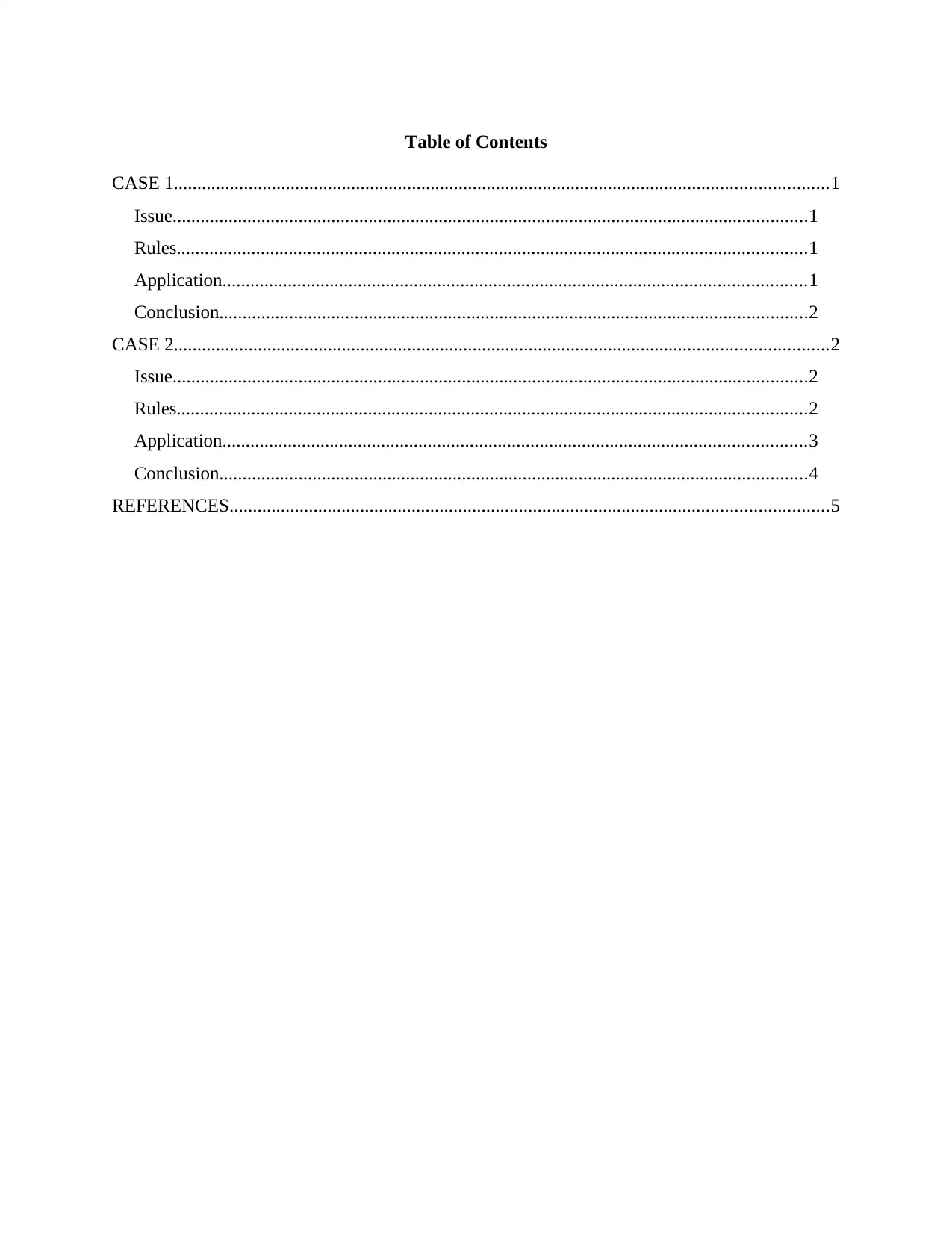
Table of Contents
CASE 1............................................................................................................................................1
Issue........................................................................................................................................1
Rules.......................................................................................................................................1
Application.............................................................................................................................1
Conclusion..............................................................................................................................2
CASE 2............................................................................................................................................2
Issue........................................................................................................................................2
Rules.......................................................................................................................................2
Application.............................................................................................................................3
Conclusion..............................................................................................................................4
REFERENCES................................................................................................................................5
CASE 1............................................................................................................................................1
Issue........................................................................................................................................1
Rules.......................................................................................................................................1
Application.............................................................................................................................1
Conclusion..............................................................................................................................2
CASE 2............................................................................................................................................2
Issue........................................................................................................................................2
Rules.......................................................................................................................................2
Application.............................................................................................................................3
Conclusion..............................................................................................................................4
REFERENCES................................................................................................................................5
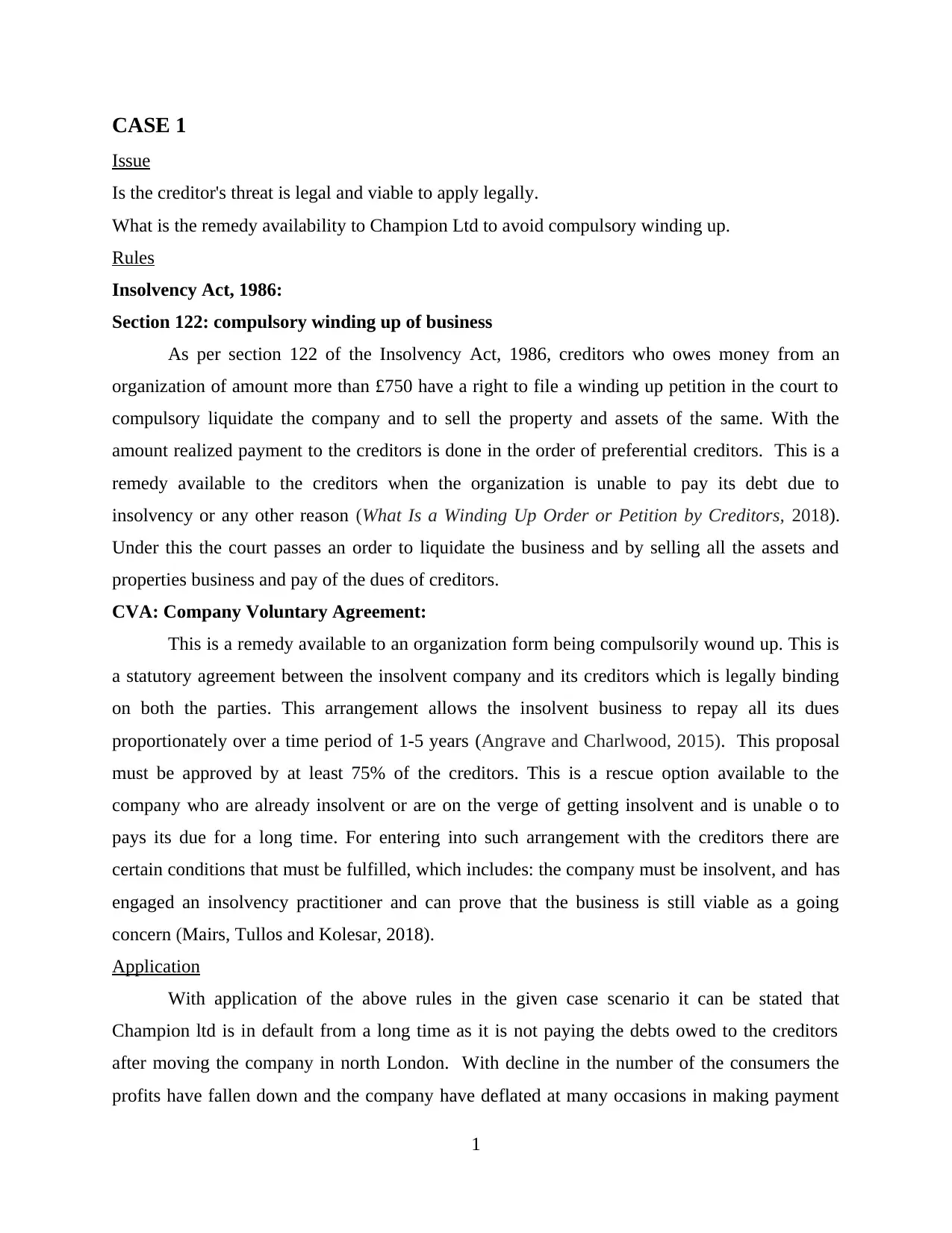
CASE 1
Issue
Is the creditor's threat is legal and viable to apply legally.
What is the remedy availability to Champion Ltd to avoid compulsory winding up.
Rules
Insolvency Act, 1986:
Section 122: compulsory winding up of business
As per section 122 of the Insolvency Act, 1986, creditors who owes money from an
organization of amount more than £750 have a right to file a winding up petition in the court to
compulsory liquidate the company and to sell the property and assets of the same. With the
amount realized payment to the creditors is done in the order of preferential creditors. This is a
remedy available to the creditors when the organization is unable to pay its debt due to
insolvency or any other reason (What Is a Winding Up Order or Petition by Creditors, 2018).
Under this the court passes an order to liquidate the business and by selling all the assets and
properties business and pay of the dues of creditors.
CVA: Company Voluntary Agreement:
This is a remedy available to an organization form being compulsorily wound up. This is
a statutory agreement between the insolvent company and its creditors which is legally binding
on both the parties. This arrangement allows the insolvent business to repay all its dues
proportionately over a time period of 1-5 years (Angrave and Charlwood, 2015). This proposal
must be approved by at least 75% of the creditors. This is a rescue option available to the
company who are already insolvent or are on the verge of getting insolvent and is unable o to
pays its due for a long time. For entering into such arrangement with the creditors there are
certain conditions that must be fulfilled, which includes: the company must be insolvent, and has
engaged an insolvency practitioner and can prove that the business is still viable as a going
concern (Mairs, Tullos and Kolesar, 2018).
Application
With application of the above rules in the given case scenario it can be stated that
Champion ltd is in default from a long time as it is not paying the debts owed to the creditors
after moving the company in north London. With decline in the number of the consumers the
profits have fallen down and the company have deflated at many occasions in making payment
1
Issue
Is the creditor's threat is legal and viable to apply legally.
What is the remedy availability to Champion Ltd to avoid compulsory winding up.
Rules
Insolvency Act, 1986:
Section 122: compulsory winding up of business
As per section 122 of the Insolvency Act, 1986, creditors who owes money from an
organization of amount more than £750 have a right to file a winding up petition in the court to
compulsory liquidate the company and to sell the property and assets of the same. With the
amount realized payment to the creditors is done in the order of preferential creditors. This is a
remedy available to the creditors when the organization is unable to pay its debt due to
insolvency or any other reason (What Is a Winding Up Order or Petition by Creditors, 2018).
Under this the court passes an order to liquidate the business and by selling all the assets and
properties business and pay of the dues of creditors.
CVA: Company Voluntary Agreement:
This is a remedy available to an organization form being compulsorily wound up. This is
a statutory agreement between the insolvent company and its creditors which is legally binding
on both the parties. This arrangement allows the insolvent business to repay all its dues
proportionately over a time period of 1-5 years (Angrave and Charlwood, 2015). This proposal
must be approved by at least 75% of the creditors. This is a rescue option available to the
company who are already insolvent or are on the verge of getting insolvent and is unable o to
pays its due for a long time. For entering into such arrangement with the creditors there are
certain conditions that must be fulfilled, which includes: the company must be insolvent, and has
engaged an insolvency practitioner and can prove that the business is still viable as a going
concern (Mairs, Tullos and Kolesar, 2018).
Application
With application of the above rules in the given case scenario it can be stated that
Champion ltd is in default from a long time as it is not paying the debts owed to the creditors
after moving the company in north London. With decline in the number of the consumers the
profits have fallen down and the company have deflated at many occasions in making payment
1
⊘ This is a preview!⊘
Do you want full access?
Subscribe today to unlock all pages.

Trusted by 1+ million students worldwide
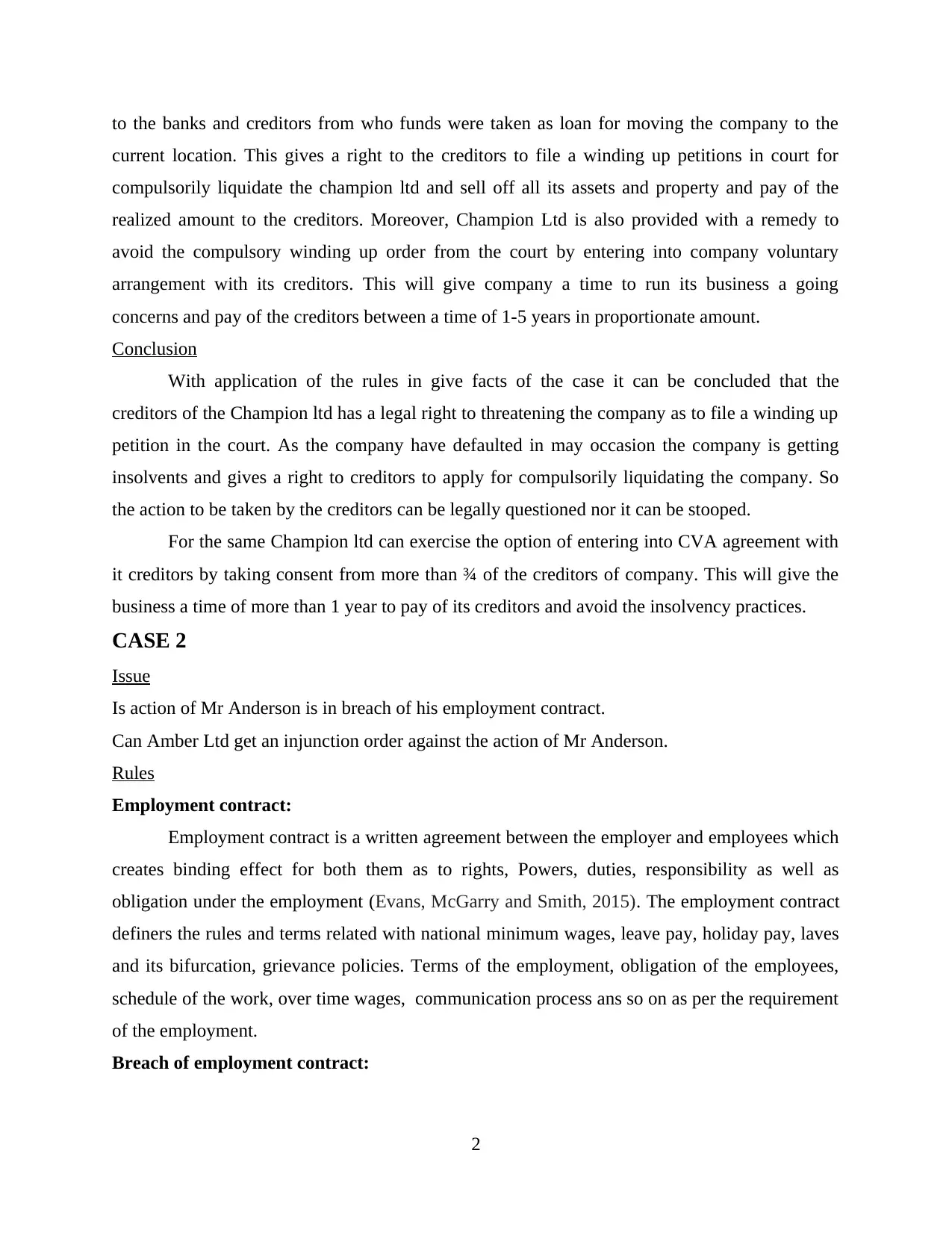
to the banks and creditors from who funds were taken as loan for moving the company to the
current location. This gives a right to the creditors to file a winding up petitions in court for
compulsorily liquidate the champion ltd and sell off all its assets and property and pay of the
realized amount to the creditors. Moreover, Champion Ltd is also provided with a remedy to
avoid the compulsory winding up order from the court by entering into company voluntary
arrangement with its creditors. This will give company a time to run its business a going
concerns and pay of the creditors between a time of 1-5 years in proportionate amount.
Conclusion
With application of the rules in give facts of the case it can be concluded that the
creditors of the Champion ltd has a legal right to threatening the company as to file a winding up
petition in the court. As the company have defaulted in may occasion the company is getting
insolvents and gives a right to creditors to apply for compulsorily liquidating the company. So
the action to be taken by the creditors can be legally questioned nor it can be stooped.
For the same Champion ltd can exercise the option of entering into CVA agreement with
it creditors by taking consent from more than ¾ of the creditors of company. This will give the
business a time of more than 1 year to pay of its creditors and avoid the insolvency practices.
CASE 2
Issue
Is action of Mr Anderson is in breach of his employment contract.
Can Amber Ltd get an injunction order against the action of Mr Anderson.
Rules
Employment contract:
Employment contract is a written agreement between the employer and employees which
creates binding effect for both them as to rights, Powers, duties, responsibility as well as
obligation under the employment (Evans, McGarry and Smith, 2015). The employment contract
definers the rules and terms related with national minimum wages, leave pay, holiday pay, laves
and its bifurcation, grievance policies. Terms of the employment, obligation of the employees,
schedule of the work, over time wages, communication process ans so on as per the requirement
of the employment.
Breach of employment contract:
2
current location. This gives a right to the creditors to file a winding up petitions in court for
compulsorily liquidate the champion ltd and sell off all its assets and property and pay of the
realized amount to the creditors. Moreover, Champion Ltd is also provided with a remedy to
avoid the compulsory winding up order from the court by entering into company voluntary
arrangement with its creditors. This will give company a time to run its business a going
concerns and pay of the creditors between a time of 1-5 years in proportionate amount.
Conclusion
With application of the rules in give facts of the case it can be concluded that the
creditors of the Champion ltd has a legal right to threatening the company as to file a winding up
petition in the court. As the company have defaulted in may occasion the company is getting
insolvents and gives a right to creditors to apply for compulsorily liquidating the company. So
the action to be taken by the creditors can be legally questioned nor it can be stooped.
For the same Champion ltd can exercise the option of entering into CVA agreement with
it creditors by taking consent from more than ¾ of the creditors of company. This will give the
business a time of more than 1 year to pay of its creditors and avoid the insolvency practices.
CASE 2
Issue
Is action of Mr Anderson is in breach of his employment contract.
Can Amber Ltd get an injunction order against the action of Mr Anderson.
Rules
Employment contract:
Employment contract is a written agreement between the employer and employees which
creates binding effect for both them as to rights, Powers, duties, responsibility as well as
obligation under the employment (Evans, McGarry and Smith, 2015). The employment contract
definers the rules and terms related with national minimum wages, leave pay, holiday pay, laves
and its bifurcation, grievance policies. Terms of the employment, obligation of the employees,
schedule of the work, over time wages, communication process ans so on as per the requirement
of the employment.
Breach of employment contract:
2
Paraphrase This Document
Need a fresh take? Get an instant paraphrase of this document with our AI Paraphraser
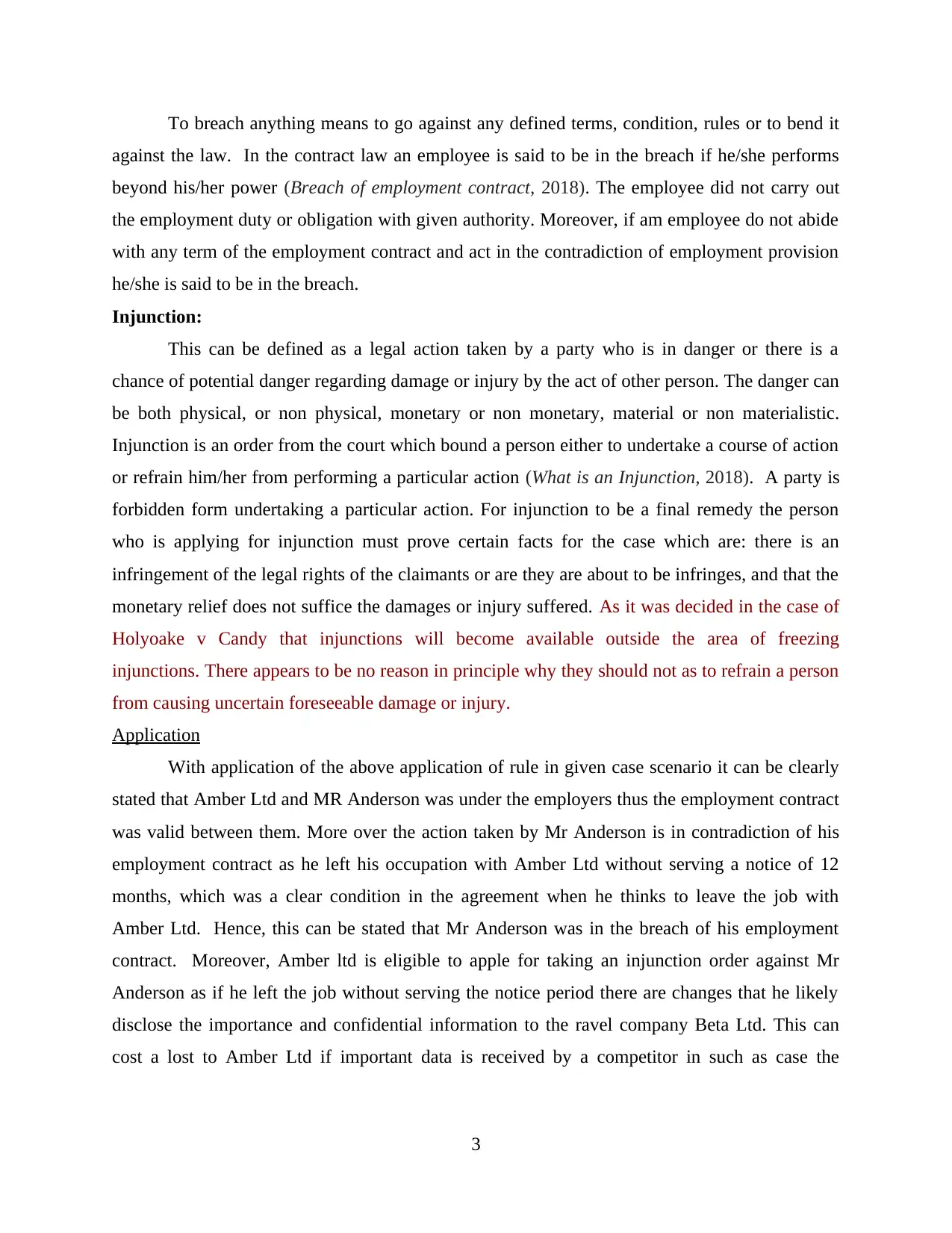
To breach anything means to go against any defined terms, condition, rules or to bend it
against the law. In the contract law an employee is said to be in the breach if he/she performs
beyond his/her power (Breach of employment contract, 2018). The employee did not carry out
the employment duty or obligation with given authority. Moreover, if am employee do not abide
with any term of the employment contract and act in the contradiction of employment provision
he/she is said to be in the breach.
Injunction:
This can be defined as a legal action taken by a party who is in danger or there is a
chance of potential danger regarding damage or injury by the act of other person. The danger can
be both physical, or non physical, monetary or non monetary, material or non materialistic.
Injunction is an order from the court which bound a person either to undertake a course of action
or refrain him/her from performing a particular action (What is an Injunction, 2018). A party is
forbidden form undertaking a particular action. For injunction to be a final remedy the person
who is applying for injunction must prove certain facts for the case which are: there is an
infringement of the legal rights of the claimants or are they are about to be infringes, and that the
monetary relief does not suffice the damages or injury suffered. As it was decided in the case of
Holyoake v Candy that injunctions will become available outside the area of freezing
injunctions. There appears to be no reason in principle why they should not as to refrain a person
from causing uncertain foreseeable damage or injury.
Application
With application of the above application of rule in given case scenario it can be clearly
stated that Amber Ltd and MR Anderson was under the employers thus the employment contract
was valid between them. More over the action taken by Mr Anderson is in contradiction of his
employment contract as he left his occupation with Amber Ltd without serving a notice of 12
months, which was a clear condition in the agreement when he thinks to leave the job with
Amber Ltd. Hence, this can be stated that Mr Anderson was in the breach of his employment
contract. Moreover, Amber ltd is eligible to apple for taking an injunction order against Mr
Anderson as if he left the job without serving the notice period there are changes that he likely
disclose the importance and confidential information to the ravel company Beta Ltd. This can
cost a lost to Amber Ltd if important data is received by a competitor in such as case the
3
against the law. In the contract law an employee is said to be in the breach if he/she performs
beyond his/her power (Breach of employment contract, 2018). The employee did not carry out
the employment duty or obligation with given authority. Moreover, if am employee do not abide
with any term of the employment contract and act in the contradiction of employment provision
he/she is said to be in the breach.
Injunction:
This can be defined as a legal action taken by a party who is in danger or there is a
chance of potential danger regarding damage or injury by the act of other person. The danger can
be both physical, or non physical, monetary or non monetary, material or non materialistic.
Injunction is an order from the court which bound a person either to undertake a course of action
or refrain him/her from performing a particular action (What is an Injunction, 2018). A party is
forbidden form undertaking a particular action. For injunction to be a final remedy the person
who is applying for injunction must prove certain facts for the case which are: there is an
infringement of the legal rights of the claimants or are they are about to be infringes, and that the
monetary relief does not suffice the damages or injury suffered. As it was decided in the case of
Holyoake v Candy that injunctions will become available outside the area of freezing
injunctions. There appears to be no reason in principle why they should not as to refrain a person
from causing uncertain foreseeable damage or injury.
Application
With application of the above application of rule in given case scenario it can be clearly
stated that Amber Ltd and MR Anderson was under the employers thus the employment contract
was valid between them. More over the action taken by Mr Anderson is in contradiction of his
employment contract as he left his occupation with Amber Ltd without serving a notice of 12
months, which was a clear condition in the agreement when he thinks to leave the job with
Amber Ltd. Hence, this can be stated that Mr Anderson was in the breach of his employment
contract. Moreover, Amber ltd is eligible to apple for taking an injunction order against Mr
Anderson as if he left the job without serving the notice period there are changes that he likely
disclose the importance and confidential information to the ravel company Beta Ltd. This can
cost a lost to Amber Ltd if important data is received by a competitor in such as case the
3
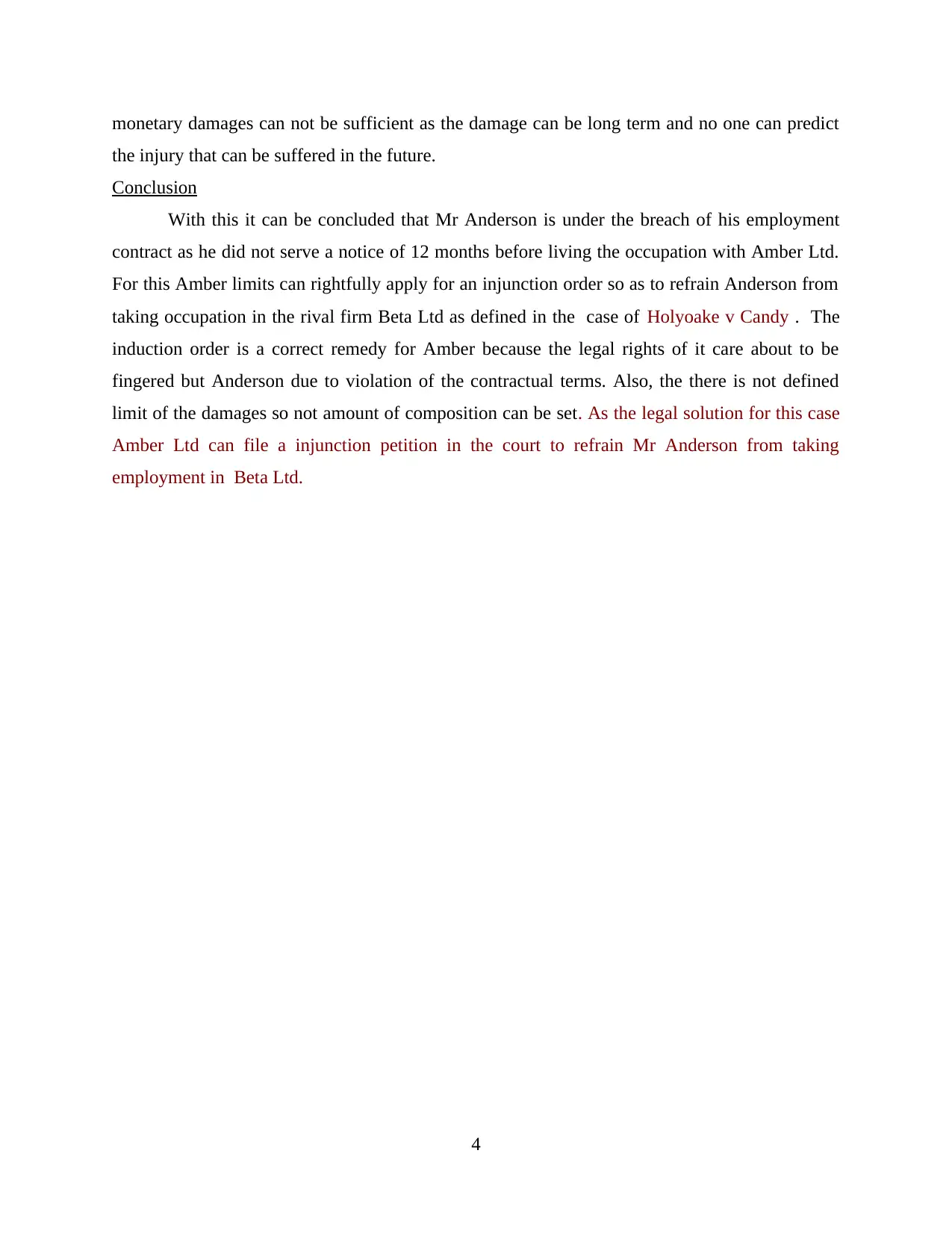
monetary damages can not be sufficient as the damage can be long term and no one can predict
the injury that can be suffered in the future.
Conclusion
With this it can be concluded that Mr Anderson is under the breach of his employment
contract as he did not serve a notice of 12 months before living the occupation with Amber Ltd.
For this Amber limits can rightfully apply for an injunction order so as to refrain Anderson from
taking occupation in the rival firm Beta Ltd as defined in the case of Holyoake v Candy . The
induction order is a correct remedy for Amber because the legal rights of it care about to be
fingered but Anderson due to violation of the contractual terms. Also, the there is not defined
limit of the damages so not amount of composition can be set. As the legal solution for this case
Amber Ltd can file a injunction petition in the court to refrain Mr Anderson from taking
employment in Beta Ltd.
4
the injury that can be suffered in the future.
Conclusion
With this it can be concluded that Mr Anderson is under the breach of his employment
contract as he did not serve a notice of 12 months before living the occupation with Amber Ltd.
For this Amber limits can rightfully apply for an injunction order so as to refrain Anderson from
taking occupation in the rival firm Beta Ltd as defined in the case of Holyoake v Candy . The
induction order is a correct remedy for Amber because the legal rights of it care about to be
fingered but Anderson due to violation of the contractual terms. Also, the there is not defined
limit of the damages so not amount of composition can be set. As the legal solution for this case
Amber Ltd can file a injunction petition in the court to refrain Mr Anderson from taking
employment in Beta Ltd.
4
⊘ This is a preview!⊘
Do you want full access?
Subscribe today to unlock all pages.

Trusted by 1+ million students worldwide
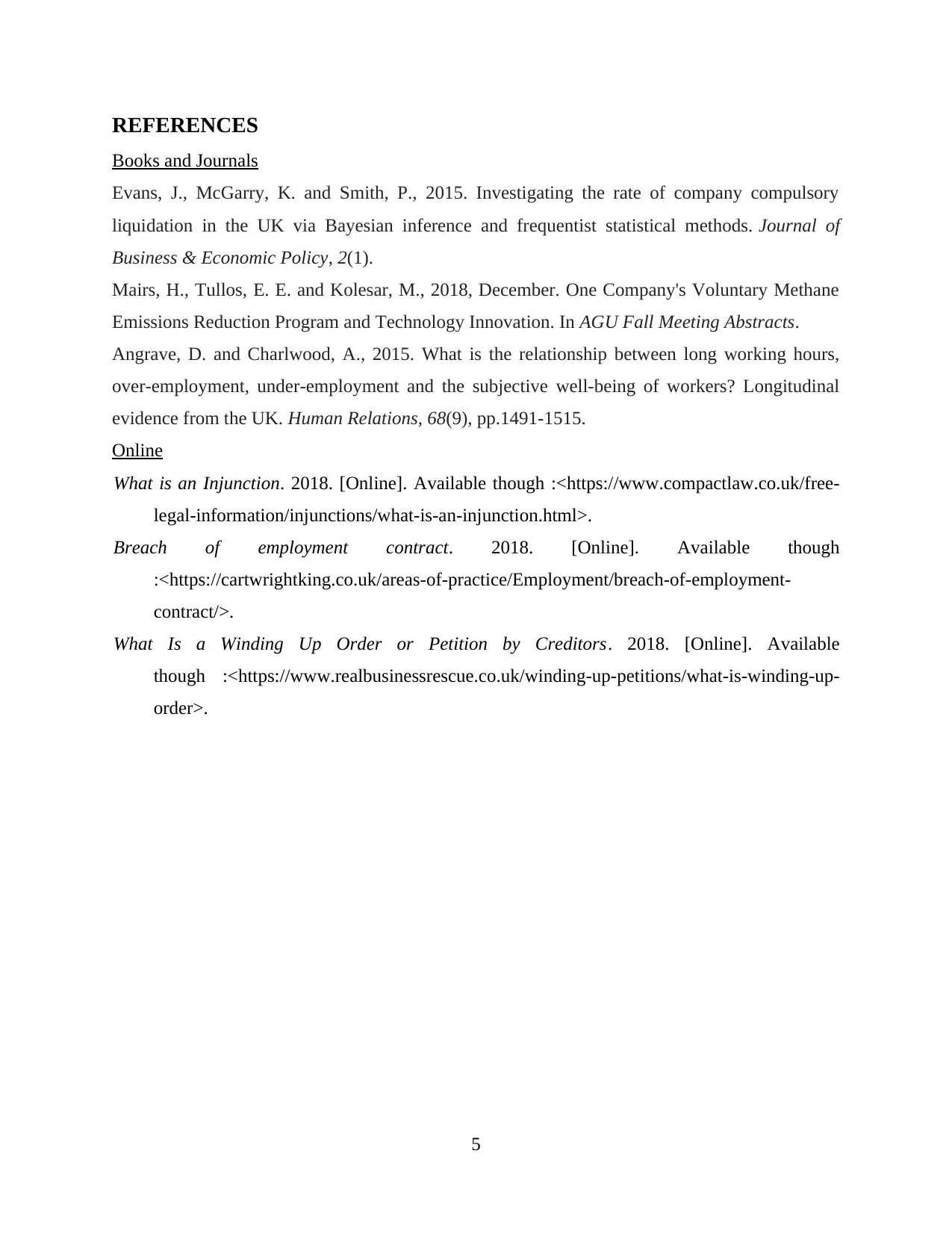
REFERENCES
Books and Journals
Evans, J., McGarry, K. and Smith, P., 2015. Investigating the rate of company compulsory
liquidation in the UK via Bayesian inference and frequentist statistical methods. Journal of
Business & Economic Policy, 2(1).
Mairs, H., Tullos, E. E. and Kolesar, M., 2018, December. One Company's Voluntary Methane
Emissions Reduction Program and Technology Innovation. In AGU Fall Meeting Abstracts.
Angrave, D. and Charlwood, A., 2015. What is the relationship between long working hours,
over-employment, under-employment and the subjective well-being of workers? Longitudinal
evidence from the UK. Human Relations, 68(9), pp.1491-1515.
Online
What is an Injunction. 2018. [Online]. Available though :<https://www.compactlaw.co.uk/free-
legal-information/injunctions/what-is-an-injunction.html>.
Breach of employment contract. 2018. [Online]. Available though
:<https://cartwrightking.co.uk/areas-of-practice/Employment/breach-of-employment-
contract/>.
What Is a Winding Up Order or Petition by Creditors. 2018. [Online]. Available
though :<https://www.realbusinessrescue.co.uk/winding-up-petitions/what-is-winding-up-
order>.
5
Books and Journals
Evans, J., McGarry, K. and Smith, P., 2015. Investigating the rate of company compulsory
liquidation in the UK via Bayesian inference and frequentist statistical methods. Journal of
Business & Economic Policy, 2(1).
Mairs, H., Tullos, E. E. and Kolesar, M., 2018, December. One Company's Voluntary Methane
Emissions Reduction Program and Technology Innovation. In AGU Fall Meeting Abstracts.
Angrave, D. and Charlwood, A., 2015. What is the relationship between long working hours,
over-employment, under-employment and the subjective well-being of workers? Longitudinal
evidence from the UK. Human Relations, 68(9), pp.1491-1515.
Online
What is an Injunction. 2018. [Online]. Available though :<https://www.compactlaw.co.uk/free-
legal-information/injunctions/what-is-an-injunction.html>.
Breach of employment contract. 2018. [Online]. Available though
:<https://cartwrightking.co.uk/areas-of-practice/Employment/breach-of-employment-
contract/>.
What Is a Winding Up Order or Petition by Creditors. 2018. [Online]. Available
though :<https://www.realbusinessrescue.co.uk/winding-up-petitions/what-is-winding-up-
order>.
5
1 out of 7
Related Documents
Your All-in-One AI-Powered Toolkit for Academic Success.
+13062052269
info@desklib.com
Available 24*7 on WhatsApp / Email
![[object Object]](/_next/static/media/star-bottom.7253800d.svg)
Unlock your academic potential
Copyright © 2020–2025 A2Z Services. All Rights Reserved. Developed and managed by ZUCOL.





